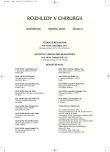Pyogenic Abscesses of the Liver
Authors:
V. Třeška; T. Skalický; V. Liška; H. Mírka; D. Šmíd; M. Vachtová
Authors‘ workplace:
Radiodiagnostická klinika FN a LF UK, přednosta: doc. MUDr. B. Kreuzberg, CSc.
; Chirurgická klinika FN a LF UK v Plzni, přednosta: prof. MUDr. V. Třeška, DrSc.
Published in:
Rozhl. Chir., 2007, roč. 86, č. 6, s. 284-287.
Category:
Monothematic special - Original
Overview
Pyogenic abscesses of the liver represent a serious nosologic unit with high morbidity and mortality rates. Their diagnostics is based on ultrasonography, computer tomography or MRI, or positrone emission tomography. The principal treatment procedure includes percutaneous draining of the abscess cavity under the ultrasound or CT control. The authors present a group of 83 subjects hospitalized from 2000 to 2006 for pyogenic abscesses of the liver. Obstruction of the bile ducts, acute cholecystitis and resections of the liver or pancreas for malignancies were recorded as the commonest causes of the abscesses. Percutaneous drainage was the treatment method of choice in 67.5% of the subjects and it included management of the causative factors and administration of antibiotics. The hospitalization period was affected by the following factors: septic conditions (p < 0.04), ALT levels (p < 0.003) – cut off 3.0 mkat/l, the abscess diameter, which may have required reoperation, (p < 0,05), diabetes mellitus (p < 0.05) and septic conditions (p < 0.001). The need for re-hospitalization due to a relaps of the pyogenic abscess of the liver correlated significantly with the following: a number (> 2) of abscesses (p < 0.04), C - reactive protein levels (p < 0.005) – cut off > 100 mg/l and septic conditions (p < 0.007). Furthermore, significat correlation was detected between the mortality rates and sepsis (p < 0.05).
Key words:
pyogenic abscess of the liver – ethiopathogenesis – treatment – morbidity and mortality rates factors
Sources
1. Ochsner, A. Pyogenic absces of the liver: an analysis of 47 cases with review of the literature. Am. J. Surg, 1938, 40, s. 292–319.
2. McFadzean, A. J. Solitary pyogenic liver abscess treated by close aspiration and antibiotics: a report of 14 consecutive cases with recovery. Br. J. Surg., 41, s. 141–152.
3. Chen, S. Y., Lin, Ch., Chang, H. M., Yu, J. C., Yu, C. Y., Chang, F. Y., Hsieh, C. B. Hepatobiliary and pancreatic: Gas - forming pyogenic liver abscess. J. Gastroenterol. Hepatol., 2007, 22, s. 133–138.
4. Rockey, D. C. Hepatobiliary infections. Curr. Opin. Gastroenterol., 2001, 17, s. 257–261.
5. Toshikuni, N., Kai, K., Sato, S., Kitano, M., Fujisawa, M. Pyogenic liver abscess after choledochoduodenostomy for biliary obstruction caused by autoimmune pancreatitis. World J. Gastroenterol., 2006, 12, s. 6397–6400.
6. Manfredi, R., Sabbatani, S., Marinacci, G. Nocardiosis as the first opportunistic disease in a patient with missed HIV infection. Pathomorphism of presentation, clinical course, and evolution. Recenti Prog. Med., 2006, 97, s. 262–265.
7. Huang, C. J., Pitt, H. A., Lipsett, P. A., et al. Pyogenic hepatic abscess: changing trends over 42 years. Ann. Surg., 1996, 223, s. 600–609.
8. Gamberini, S., Anania, G., Incasa, E., Zangirolami, A., Tampieri, M., Boari, B., Benea, G., Manfredini, R. Staphylococcus hemolyticus liver abscess as an uncommon presentation of silent colonic cancer: a case report. J. Am. Geriatr. Soc., 2006, 54, s. 1619–1620.
9. Bahloul, M., Chaari, A., Bouaziz-Khlaf, N., Kallel, H., Herguefi, L., Chelly, H., Ben, H. C., Bouaziz, M. Multiple pyogenic liver abscess. World J Gastroenterol, 2006, 12,s. 2962-2963.
10. Golia, P, Sadler, M. Pyogenic liver abscess: Klebsielly as an emerging pathogen. Emerg. Radiol., 2006, 13, s. 87–88.
11. Smith, B. M., Zyromski, N. J., Allison, D. C. Community-acquired methicillin-resistant Staphylococcus liver abscess. J. Gastroenterol. Hepatol., 2007, 141, s. 110–111.
12. Grunder, R., Baumann, U. A. Diagnosis and treatment of a liver abscess with contrast-enhanced ultrasound. Schweiz Rundsch. Med. Prax., 2006, 95, s. 1233–1236.
13. Kim, S. B., Je, B. K., Lee, K. Y., Lee, S. H., Chung, H. H., Cha, S. H. Computed tomographic differences of pyogenic liver abscesses causedby Klebsiella pneumoniae and non-Klebsiella pneumoniae. J. Comput. Assist. Tomogr., 2007, 31, s. 59–65.
14. Sommariva, A, Donisi, P. M., Leoni, G., Ardit, S., Renier, M., Gnocato, B., Tremolada, C. Pyogenic liver abscess: is drainage always possible? Eur. J. Gastroenterol. Hepatol., 2006, 18, s. 435–436.
15. Muorah, M., Hinds, R., Verma, A., Yu, D., Samyn, M., Mieli-Vergani, G., Hadzic, N. Liver abscesses in children: a single center experience in the developed world. J. Pediatr. Gastroenterol. Nutr., 2006, 42, s. 201–206.
16. Chong, V. H. Large pyogenic liver abscess: open surgical drainage for all? Ann. Surg., 2006, 244, s. 163–164.
17. Strong, R. W., Fawcett, J., Lynch, S. V. Hepatectomy for pyogenic liver abscess. HPB, 2003, 5, s. 86–90.
Labels
Surgery Orthopaedics Trauma surgeryArticle was published in
Perspectives in Surgery

2007 Issue 6
- Metamizole vs. Tramadol in Postoperative Analgesia
- Metamizole at a Glance and in Practice – Effective Non-Opioid Analgesic for All Ages
- Metamizole in perioperative treatment in children under 14 years – results of a questionnaire survey from practice
Most read in this issue
- Laparoscopic Management of Epidermoid Spleen Cyst
- Complications of the Laparoscopic Appendectomy
- Pyogenic Abscesses of the Liver
- Disorder of Vertebral Metastasis
